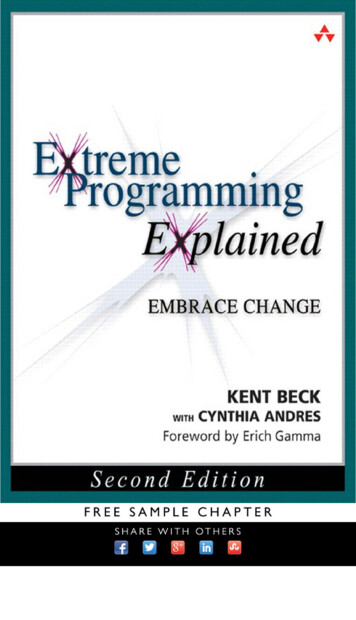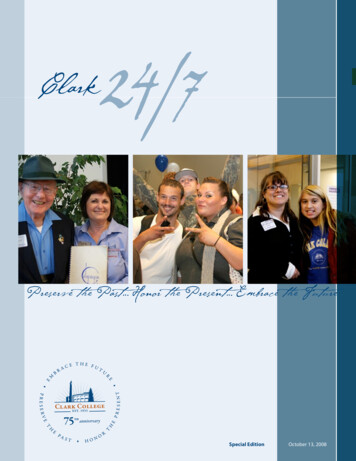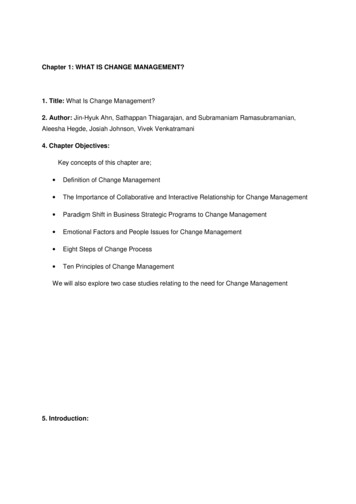
Transcription
Praise for Extreme Programming Explained, Second Edition“In this second edition of Extreme Programming Explained, Kent Beck organizes and presents five years’ worth of experiences, growth, and change revolving around XP. If you are seriously interested in understanding how you andyour team can start down the path of improvement with XP, you must readthis book.”—Francesco Cirillo, Chief Executive Officer, XPLabs S.R.L.“The first edition of this book told us what XP was—it changed the way manyof us think about software development. This second edition takes it fartherand gives us a lot more of the ‘why’ of XP, the motivations and the principlesbehind the practices. This is great stuff. Armed with the ‘what’ and the ‘why,’we can now all set out to confidently work on the ‘how’: how to run ourprojects better, and how to get agile techniques adopted in our organizations.”—Dave Thomas, The Pragmatic Programmers LLC“This book is dynamite! It was revolutionary when it first appeared a few yearsago, and this new edition is equally profound. For those who insist on cookbook checklists, there’s an excellent chapter on ‘primary practices,’ but I urgeyou to begin by truly contemplating the meaning of the opening sentence inthe first chapter of Kent Beck’s book: ‘XP is about social change.’ You shoulddo whatever it takes to ensure that every IT professional and every IT manager—all the way up to the CIO—has a copy of Extreme ProgrammingExplained on his or her desk.”—Ed Yourdon, author and consultant“XP is a powerful set of concepts for simplifying the process of softwaredesign, development, and testing. It is about minimalism and incrementalism,which are especially useful principles when tackling complex problems thatrequire a balance of creativity and discipline.”—Michael A. Cusumano, Professor, MIT Sloan School of Management, andauthor of The Business of Software“Extreme Programming Explained is the work of a talented and passionatecraftsman. Kent Beck has brought together a compelling collection of ideasabout programming and management that deserves your full attention. Myonly beef is that our profession has gotten to a point where such commonsense ideas are labeled ‘extreme.’ . . .”—Lou Mazzucchelli, Fellow, Cutter Business Technology Council
“If your organization is ready for a change in the way it develops software,there’s the slow incremental approach, fixing things one by one, or the fasttrack, jumping feet first into Extreme Programming. Do not be frightened bythe name, it is not that extreme at all. It is mostly good old recipes and common sense, nicely integrated together, getting rid of all the fat that has accumulated over the years.”—Philippe Kruchten, UBC, Vancouver, British Columbia“Sometimes revolutionaries get left behind as the movement they started takeson a life of its own. In this book, Kent Beck shows that he remains ahead ofthe curve, leading XP to its next level. Incorporating five years of feedback, thisbook takes a fresh look at what it takes to develop better software in less timeand for less money. There are no silver bullets here, just a set of practical principles that, when used wisely, can lead to dramatic improvements in softwaredevelopment productivity.”—Mary Poppendieck, author of Lean Software Development: An Agile Toolkit“Kent Beck has revised his classic book based on five more years of applying andteaching XP. He shows how the path to XP is both easy and hard: It can bestarted with fewer practices, and yet it challenges teams to go farther than ever.”—William Wake, independent consultant“With new insights, wisdom from experience and clearer explanations of theart of Extreme Programming, this edition of Beck’s classic will help many realize the dream of outstanding software development.”—Joshua Kerievsky, author, Refactoring to Patterns, and Founder, IndustrialLogic, Inc.“XP has changed the way our industry thinks about software development. Itsbrilliant simplicity, focused execution, and insistence on fact-based planningover speculation have set a new standard for software delivery.”—David Trowbridge, Architect, Microsoft Corporation
Extreme ProgrammingExplainedSecond Edition
The XP SeriesKent Beck, Series AdvisorExtreme Programming, familiarly known as XP, is a discipline of the businessof software development that focuses the whole team on common, reachablegoals. Using the values and principles of XP, teams apply appropriate XP practices in their own context. XP practices are chosen for their encouragement ofhuman creativity and their acceptance of human frailty. XP teams producequality software at a sustainable pace.One of the goals of XP is to bring accountability and transparency to softwaredevelopment, to run software development like any other business activity.Another goal is to achieve outstanding results—more effective and efficientdevelopment with far fewer defects than is currently expected. Finally, XP aimsto achieve these goals by celebrating and serving the human needs of everyonetouched by software development—sponsors, managers, testers, users, andprogrammers.The XP series exists to explore the myriad variations in applying XP. While XPbegan as a methodology addressing small teams working on internal projects,teams worldwide have used XP for shrink-wrap, embedded, and large-scaleprojects as well. The books in the series describe how XP applies in these andother situations, addressing both technical and social concerns.Change has come to software development. However, change can be seen asan opportunity, not a threat. With a plan for change, teams can harness thisopportunity to their benefit. XP is one such plan for change.Titles in the SeriesExtreme Programming Applied: Playing to Win, Ken Auer and Roy MillerExtreme Programming Explained, Second Edition: Embrace Change, Kent Beckwith Cynthia AndresExtreme Programming Explored, William C. WakeExtreme Programming for Web Projects, Doug Wallace, Isobel Raggett,and Joel AufgangExtreme Programming Installed, Ron Jeffries, Ann Anderson, and Chet HendricksonPlanning Extreme Programming, Kent Beck and Martin FowlerTesting Extreme Programming, Lisa Crispin and Tip HouseFor more information, check out the series Web site at www.awprofessional.com/series/XP
Extreme ProgrammingExplainedSecond EditionEmbrace ChangeKent Beckwith Cynthia AndresBoston
The author and publisher have taken care in the preparation of this book, but make no expressed orimplied warranty of any kind and assume no responsibility for errors or omissions. No liability isassumed for incidental or consequential damages in connection with or arising out of the use of theinformation or programs contained herein.Publisher: John WaitEditor in Chief: Don O’HaganAcquisitions Editor: Paul PetraliaManaging Editor: John FullerProject Editors: Julie Nahil and Kim Arney MulcahyCompositor: Kim Arney MulcahyManufacturing Buyer: Carol MelvilleThe publisher offers excellent discounts on this book when ordered in quantity for bulk purchases orspecial sales, which may include electronic versions and/or custom covers and content particular toyour business, training goals, marketing focus, and branding interests. For more information, pleasecontact:U. S. Corporate and Government Sales(800) 382-3419corpsales@pearsontechgroup.comFor sales outside the U. S., please contact:International Salesinternational@pearsoned.comVisit us on the Web: www.awprofessional.comLibrary of Congress Cataloging-in-Publication DataBeck, Kent.extreme programming explained: embrace change / Kent Beck with Cynthia Andres. — 2nd ed.p. cm.Includes bibliographical references and index.ISBN 0-321-27865-8 (alk. paper)1. Computer software—Development. 2. eXtreme programming. I. Title.QA76.76.D47B434 2004005.1—dc222004057463Text copyright 2005 Pearson Education, Inc.Inside cover art copyright 2004 by Kent BeckAll rights reserved. Printed in the United States of America. This publication is protected by copyright,and permission must be obtained from the publisher prior to any prohibited reproduction, storage in aretrieval system, or transmission in any form or by any means, electronic, mechanical, photocopying,recording, or likewise. For information regarding permissions, write to:Pearson Education, Inc.Rights and Contracts DepartmentOne Lake StreetUpper Saddle River, NJ 07458Many of the designations used by manufacturers and sellers to distinguish their products are claimed astrademarks. Where those designations appear in this book and we were aware of a trademark claim, thedesignations have been printed in initial caps or all caps.ISBN 0-321-27865-8Text printed in the United States on recycled paper at Courier in Stoughton, Massachusetts.Text printed in the United States on recycled paper at Courier in Westford, Massachusetts.Tenth printing, January 2012
To CindeeWithout you, this book would still be about programmers hiding in acorner. Without you, I would still be one of those programmers.
This page intentionally left blank
Note To ProgrammersEven programmers can be whole people in the real world. XP is anopportunity to test yourself, to be yourself, to realize that maybe you’vebeen fine all along and just hanging with the wrong crowd.
This page intentionally left blank
ContentsForeword to the Second Edition . xvForeword to the First Edition . xviiPreface . xxiChapter 1Section 1What is XP? .1Exploring XP .9Chapter 2Learning to Drive .11Chapter 3Values, Principles, and Practices .13Chapter 4 Values .17Communication .18Simplicity .18Feedback .19Courage .20Respect .21Others .21Chapter 5 Principles .23Humanity .24Economics .25Mutual Benefit .26xi
Self-Similarity .27Improvement .28Diversity .29Reflection .29Flow .30Opportunity .30Redundancy .31Failure .32Quality .32Baby Steps .33Accepted Responsibility .34Chapter 6Practices .35Chapter 7 Primary Practices .37Sit Together .37Whole Team .38Informative Workspace .39Energized Work .41Pair Programming .42Stories .44Weekly Cycle .46Quarterly Cycle .47Slack .48Ten-Minute Build .49Continuous Integration .49Test-First Programming .50Incremental Design .51Chapter 8Getting Started .55Chapter 9 Corollary Practices .61Real Customer Involvement .61Incremental Deployment .62Team Continuity .63Shrinking Teams .64Root-Cause Analysis .64Shared Code .66Code and Tests .66Single Code Base .67xiiContents
Daily Deployment .68Negotiated Scope Contract .69Pay-Per-Use .69Chapter 10 The Whole XP Team .73Testers .74Interaction Designers .75Architects .75Project Managers .76Product Managers .77Executives .78Technical Writers .80Users .81Programmers .81Human Resources .81Roles .82Chapter 11The Theory of Constraints .85Chapter 12Planning: Managing Scope .91Chapter 13Testing: Early, Often, and Automated .97Chapter 14 Designing: The Value of Time .103Simplicity .109Chapter 15 Scaling XP .111Number of People .111Investment .113Size of Organization .113Time .114Problem Complexity .115Solution Complexity .115Consequences of Failure .116Chapter 16Interview .119Section 2Philosophy of XP .123Chapter 17Creation Story .125Chapter 18Taylorism and Software .131Contentsxiii
Chapter 19Toyota Production System .135Chapter 20 Applying XP .139Choosing a Coach .143When You Shouldn’t Use XP .144Chapter 21 Purity .145Certification and Accreditation .146Chapter 22Offshore Development .149Chapter 23The Timeless Way of Programming .153Chapter 24Community and XP .157Chapter 25Conclusion .159Annotated Bibliography .161Index .175xivContents
Foreword tothe Second EditionWow—the second edition. I cannot believe that five years have alreadypassed since the appearance of the first edition. When Kent pinged meto write a foreword to the second edition I asked him for a manuscriptversion with change bars. What a silly request—the book is a fullrewrite! In the second edition of XP Explained Kent revisits XP andapplies the XP paradigm—stay aware, adapt, change—to XP itself. Kenthas revisited, cleaned-up, and refactored every bit of XP Explained andintegrated many new insights. The result is XP Explained even betterexplained!This is an excellent opportunity to reflect on how XP has influencedmy own software development. Shortly after the first edition of XPExplained I became involved in the Eclipse project and it is nowabsorbing all my software energy. Eclipse isn’t run under the pure XPflag. We follow agile practices; however, the XP influences are easy tospot. The most obvious one is that we have encoded several XP practices directly into our tool. Refactoring, unit testing, and immediatefeedback as you code are now an integral part of our toolset. Moreover,since we are “eating our own dog food” we use these practices in ourday-to-day development. Even more interesting are the XP influencesone can spot in our development process. Eclipse is an open sourceproject and one of our goals is to practice completely transparent development. The rationale is simple; if you don’t know where the project isgoing you cannot help out or provide feedback. XP practices help us toachieve this goal.xv
Here is how we apply some of these practices: Testing early, often and automated—To get a green check markfor our latest builds more than 21,000 unit tests have to pass.Incremental design—We invest in the design every day, but we havethe additional constraint that we need to keep our APIs stable.Daily deployment—Components deploy their code at least onceper day and develop on top of the deployed code to get immediate feedback and to catch problems early.Customer involvement—We are lucky to have an active user community that isn’t shy and provides us with continuous feedback.We listen and do our best to be responsive.Continuous integration—The latest code is built every night. Thenightly builds provide us with insights about cross-componentintegration problems. Once per week we do an integration buildwhere we ensure integrity across all components.Short development cycles—Our cycles are longer than the XP-suggested one week cycles, but the goals are the same. Each of our sixweek cycles ends in a milestone build which have become theheartbeat of our project. The goal of each milestone build is toshow progress (which keeps us honest) and to deliver it with ahigh enough level of quality that our community can really use itand provide feedback (which keeps us even more honest).Incremental planning—After a release we develop an embryonicoverall plan which we evolve throughout the release cycle. Thisplan is posted on our website early so that our user communitycan join the dialog. The exception is the milestones, which arefixed in the first planning iteration since they define the heartbeatof our project.Despite the fact that we have not adopted XP in its entirety, we aregetting a lot out of the above XP practices. In particular, they help us toreduce our development stress! All these practices, underpinned by astrong team committed to shipping quality software on time, are ourkeys to hitting the projected milestones and ship dates with precision.xviForeword to the Second Edition
Kent is continuing to challenge my views on software development.While reading the book I’ve discovered several practices that I will addto my try-list. I suggest you do the same and accept the XP invitationto improve the way you develop software and to create outstandingsoftware.Erich GammaSeptember 2004Foreword to the Second Editionxvii
This page intentionally left blank
Foreword tothe First EditionExtreme Programming (XP) nominates coding as the key activitythroughout a software project. This can’t possibly work!Time to reflect for a second about my own development work. Iwork in a just-in-time software culture with compressed release cyclesspiced up with high technical risk. Having to make change your friendis a survival skill. Communication in and across often geographicallyseparated teams is done with code. We read code to understand new orevolving subsystem APIs. The life cycle and behavior of complex objectsis defined in test cases, again in code. Problem reports come with testcases demonstrating the problem, once more in code. Finally, we continuously improve existing code with refactoring. Obviously our development is code-centric, but we successfully deliver software in time, sothis can work after all.It would be wrong to conclude that all that is needed to deliver software is daredevil programming. Delivering software is hard, and delivering quality software in time is even harder. To make it work requiresthe disciplined use of additional best practices. This is where Kent startsin his thought-provoking book on XP.Kent was among the leaders at Tektronix to recognize the potentialof man in the loop pair programming in Smalltalk for complex engineering applications. Together with Ward Cunningham, he inspired much ofthe pattern movement that has had such an impact on my career. XPdescribes an approach to development that combines practices used bymany successful developers that got buried under the massive literaturexix
on software methods and process. Like patterns, XP builds on best practices such as unit testing, pair programming, and refactoring. In XPthese practices are combined so that they complement and often controleach other. The focus is on the interplay of the different practices, whichmakes this book an important contribution. There is a single goal todeliver software with the right functionality and hitting dates. WhileOTI’s successful Just In Time Software process is not pure XP, it hasmany common threads.I’ve enjoyed my interaction with Kent and practicing XP episodes ona little thing called JUnit. His views and approaches always challengethe way I approach software development. There is no doubt that XPchallenges some traditional big M approaches; this book will let youdecide whether you want to embrace XP or not.Erich GammaAugust 1999xxForeword to the First Edition
PrefaceThe goal of Extreme Programming (XP) is outstanding software development. Software can be developed at lower cost, with fewer defects,with higher productivity, and with much higher return on investment.The same teams that are struggling today can achieve these results bycareful attention to and refinement of how they work, by pushing ordinary development practices to the extreme.There are better ways and worse ways to develop software. Goodteams are more alike than they are different. No matter how good orbad your team you can always improve. I intend this book as a resourcefor you as you try to improve.This book is my personal take on what it is that good software development teams have in common. I’ve taken things I’ve done that haveworked well and things I’ve seen done that worked well and distilledthem to what I think is their purest, most “extreme” form. What I’mmost struck with in this process is the limitations of my own imagination in this effort. Practices that seemed impossibly extreme five yearsago, when the first edition of this book was published, are now common. Five years from now the practices in this book will probably seemconservative.If I only talked about what good teams do I would be missing thepoint. There are legitimate differences between outstanding teams’actions based on the context in which they work. Looking below thesurface, where their activities become ripples in the river hinting atxxi
shapes below, there is an intellectual and intuitive substrate to softwaredevelopment excellence that I have also tried to distill and document.Critics of the first edition have complained that it tries to force themto program in a certain way. Aside from the absurdity of me being ableto control anyone else’s behavior, I’m embarrassed to say that was myintention. Relinquishing the illusion of control of other people’s behavior and acknowledging each individual’s responsibility for his or herown choices, in this edition I have tried to rephrase my message in apositive, inclusive way. I present proven practices you can add to yourbag of tricks. No matter the circumstance you can always improve. You can always start improving with yourself. You can always start improving today.AcknowledgmentsI would like to thank my most excellent group of reviewers, each ofwhom spent considerable time reading and commenting on the manuscript: Francesco Cirillo, Steve McConnell, Mike Cohn, David Anderson, Joshua Kerievsky, Beth Andres-Beck, and Bill Wake. The SiliconValley Patterns Group also provided valuable feedback on drafts: ChrisLopez, John Parello, Phil Goodwin, Dave Smith, Keith Ray, RussRufer, Mark Taylor, Sudarsan Piduri, Tracy Bialik, Jan Chong, RiturajKirti, Carlos Mc Evilly, Bill Venners, Wayne Vucenic, Raj Baskaran, TimHuske, Patrick Manion, Jeffrey Miller, and Andrew Chase. Thanks tothe production staff at Pearson: Julie Nahil, Kim Arney Mulcahy, andMichelle Vincenti. Paul Petralia, my editor, saw me through difficulttimes with humor and understanding. He taught me lessons in thevalue of relationships. Erich Gamma, my pair programming partner,provided conversation and feedback. The owners and staff of BluestoneBakery and Cafe kept the hot chocolate and broadband flowing. JoëlleAndres-Beck edited copy and collected garbage. All of my children;Lincoln, Lindsey, Forrest, and Joëlle; spent many hours at Bluestonewhile we edited. Gunjan Doshi provided thought-provoking questions.Finally, I cannot possibly give sufficient thanks to my wife, developmental editor, friend, and intellectual colleague Cynthia Andres.xxiiPreface
C hapter 1What is XP?Extreme Programming (XP) is about social change. It is about lettinggo of habits and patterns that were adaptive in the past, but now get inthe way of us doing our best work. It is about giving up the defensesthat protect us but interfere with our productivity. It may leave us feeling exposed.It is about being open about what we are capable of doing and thendoing it. And, allowing and expecting others to do the same. It isabout getting past our adolescent surety that “I know better thaneveryone else and all I need is to be left alone to be the greatest.” It isabout finding our adult place in the larger world, finding our place inthe community including the realm of business/work. It is about theprocess of becoming more of our best selves and in the process ourbest as developers. And, it is about writing great code that is reallygood for business.Good relationships lead to good business. Productivity and confidence are related to our human relationships in the workplace as well asto our coding or other work activities. You need both technique andgood relationships to be successful. XP addresses both.Prepare for success. Don’t protect yourself from success by holdingback. Do your best and then deal with the consequences. That’sextreme. You leave yourself exposed. For some people that is incredibly scary, for others it’s daily life. That is why there are such polarizedreactions to XP.1
XP is a style of software development focusing on excellent application of programming techniques, clear communication, and teamworkwhich allows us to accomplish things we previously could not evenimagine. XP includes: A philosophy of software development based on the values ofcommunication, feedback, simplicity, courage, and respect. A body of practices proven useful in improving software development. The practices complement each other, amplifying theireffects. They are chosen as expressions of the values. A set of complementary principles, intellectual techniques fortranslating the values into practice, useful when there isn’t a practice handy for your particular problem. A community that shares these values and many of the samepractices.XP is a path of improvement to excellence for people coming togetherto develop software. It is distinguished from other methodologies by:
Wow—the second edition. I cannot believe that five years have already passed since the appearance of the first edition. When Kent pinged me to write a foreword to the second edition I asked him for a manuscript version with change bars. What a silly request—the book is a full rewrite! In the second











